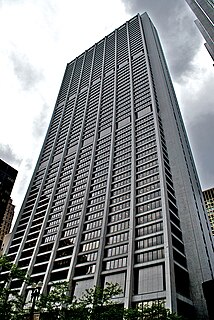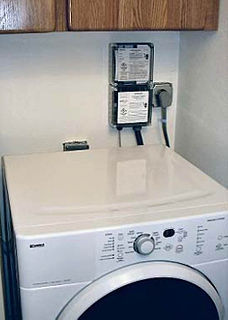The British Columbia Hydro and Power Authority, operating as BC Hydro, is a Canadian electric utility in the province of British Columbia. It is the main electricity distributor, serving 1.8 million customers in most areas, with the exception of the City of New Westminster, where the city runs its own electrical department and the Kootenay, Okanagan, and Similkameen regions, where FortisBC, a subsidiary of Fortis Inc. directly provides electric service to 213,000 customers and supplies municipally owned utilities in the same area. As a provincial Crown corporation, BC Hydro reports to the BC Ministry of Energy, Mines and Low Carbon Innovation, and is regulated by the British Columbia Utilities Commission (BCUC). Its mandate is to generate, purchase, distribute and sell electricity.

The Potomac Electric Power Company (PEPCO) is a public utility that supplies electric power to the city of Washington, D.C. and to surrounding communities in Maryland. It is owned by Exelon.
Energy demand management, also known as demand-side management (DSM) or demand-side response (DSR), is the modification of consumer demand for energy through various methods such as financial incentives and behavioral change through education.

Exelon Corporation is an American Fortune 100 energy company headquartered in Chicago, Illinois and incorporated in Pennsylvania. It generates revenues of approximately $33.5 billion and employs approximately 33,400 people. Exelon is the largest electric parent company in the United States by revenue, the largest regulated electric utility in the United States with approximately 10 million customers, and also the largest operator of nuclear power plants in the United States and the largest non-governmental operator of nuclear power plants in the world.

Baltimore Gas and Electric Company (BGE) is a subsidiary of the Exelon Corporation and Maryland’s largest gas and electric utility. BGE earlier had created the holding company Constellation Energy in 1999. Constellation Energy was acquired by Exelon in 2012.

Delmarva Power is an energy company that provides electricity and natural gas to customers on portions of the Delmarva Peninsula in the states of Delaware and Maryland. The company is a subsidiary of Exelon.
Pepco Holdings was a holding company incorporated in February 2001 for the purpose of effecting the acquisition of Conectiv Power Delivery by Potomac Electric Power Company. The acquisition was completed on August 1, 2002 at which time Pepco and Conectiv became wholly owned subsidiaries of PHI. Conectiv itself had been formed in 1998 to be the holding company of Delmarva Power & Light Company and Atlantic City Electric Company (ACE) in connection with the combination of DPL and ACE. In 2005, PHI resumed the use of the Delmarva Power and ACE brands for purposes of operations, with the result that Conectiv Energy was the only remaining Conectiv brand and was restricted for PHI's energy production facilities. Operations of the various companies controlled by Pepco Holdings take place in the Mid-Atlantic states of the United States. Pepco serves Washington, D.C. and its Maryland suburbs, Delmarva Power serves the Delaware and Maryland portions of the Delmarva Peninsula, and Atlantic City Electric serves South Jersey. In 2008, Delmarva Power sold its service area in the Virginia portion of the peninsula to A&N Electric Cooperative and Old Dominion Electric Cooperative for $44 million. In April 2010, Conectiv Energy was sold to Calpine Corporation.

Demand response is a change in the power consumption of an electric utility customer to better match the demand for power with the supply. Until recently electric energy could not be easily stored, so utilities have traditionally matched demand and supply by throttling the production rate of their power plants, taking generating units on or off line, or importing power from other utilities. There are limits to what can be achieved on the supply side, because some generating units can take a long time to come up to full power, some units may be very expensive to operate, and demand can at times be greater than the capacity of all the available power plants put together. Demand response seeks to adjust the demand for power instead of adjusting the supply.

A negawatt market is a theoretical energy market where the commodity traded is a negawatt-hour, a unit of energy saved as a direct result of energy conservation measures.

A smart meter is an electronic device that records information such as consumption of electric energy, voltage levels, current, and power factor. Smart meters communicate the information to the consumer for greater clarity of consumption behavior, and electricity suppliers for system monitoring and customer billing. Smart meters typically record energy near real-time, and report regularly, short intervals throughout the day. Smart meters enable two-way communication between the meter and the central system. Such an advanced metering infrastructure (AMI) differs from automatic meter reading (AMR) in that it enables two-way communication between the meter and the supplier. Communications from the meter to the network may be wireless, or via fixed wired connections such as power line carrier (PLC). Wireless communication options in common use include cellular communications, Wi-Fi, wireless ad hoc networks over Wi-Fi, wireless mesh networks, low power long-range wireless (LoRa), Wize ZigBee, and Wi-SUN.
Electricity deregulation in Texas, approved by Texas Senate Bill 7 on January 1, 2002, called for the creation of the Electric Utility Restructuring Legislative Oversight Committee to oversee implementation of the bill. According to the law, deregulation would be phased in over several years.
Nova Scotia Power Inc. is a vertically integrated electric utility in Nova Scotia, Canada. It is privately owned by Emera and regulated by the provincial government via the Nova Scotia Utility and Review Board (NSUARB). Nova Scotia Power Inc provides electricity to 520,000 residential, commercial and industrial customers in Nova Scotia.

A smart grid is an electrical grid which includes a variety of operation and energy measures including:
The Southern Maryland Electric Cooperative (SMECO) is an electric distribution cooperative which is headquartered in Hughesville, Maryland, United States. SMECO serves approximately 161,000 customers in Calvert, Charles, Prince George's, and St. Mary's counties of southern Maryland. Under its rules as a nonprofit cooperative, SMECO passes on its costs to its customer-members without markup or profit.
An Energy Rebate Program, or Energy Credit Incentive Program, provides a cash rebate program for customers planning to install new, energy efficient information technology (IT) equipment or cooling systems. These programs push companies to construct more energy efficient data centers, or to consolidate compute, storage and networking resources via virtualization technologies.

The electricity sector of the United States includes a large array of stakeholders that provide services through electricity generation, transmission, distribution and marketing for industrial, commercial, public and residential customers. It also includes many public institutions that regulate the sector. In 1996, there were 3,195 electric utilities in the United States, of which fewer than 1,000 were engaged in power generation. This leaves a large number of mostly smaller utilities engaged only in power distribution. There were also 65 power marketers. Of all utilities, 2,020 were publicly owned, 932 were rural electric cooperatives, and 243 were investor-owned utilities. The electricity transmission network is controlled by Independent System Operators or Regional Transmission Organizations, which are not-for-profit organizations that are obliged to provide indiscriminate access to various suppliers in order to promote competition.

A community solar farm or garden is a solar power installation that accepts capital from and provides output credit and tax benefits to individual and other investors. In some systems you buy individual solar panels which are installed in the farm after your purchase. In others you purchase kW capacity or kWh of production. The farm's power output is credited to investors in proportion to their investment, with adjustments to reflect ongoing changes in capacity, technology, costs and electricity rates. Companies, cooperatives, governments or non-profits operate the farms.
An electric utility is a company in the electric power industry that engages in electricity generation and distribution of electricity for sale generally in a regulated market. The electrical utility industry is a major provider of energy in most countries.

The electricity sector in the Philippines provides electricity through power generation, transmission, and distribution to many parts of the Philippines. The Philippines is divided into three electrical grids, one each for Luzon, the Visayas and Mindanao. As of June 2016, the total installed capacity in the Philippines was 20,055 megawatts (MW), of which 14,348 MW was on the Luzon grid. As of June, 2016, the all-time peak demand on Luzon was 9,726 MW at 2:00 P.M. on May 2, 2016; on Visayas was 1,878 MW at 2:00 P.M. on May 11, 2016; and on Mindanao was 1,593 MW at 1:35 P.M. on June 8, 2016. However, about 12% of Filipinos have no access to electricity. The Philippines is also one of the countries in the world that has a fully functioning electricity market since 2006 called the Philippine Wholesale Electricity Spot Market(WESM) and is operated by an independent market operator.










